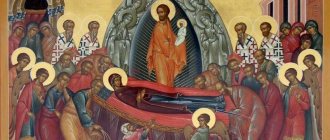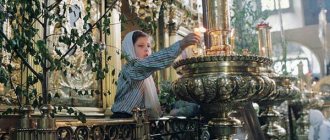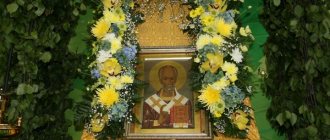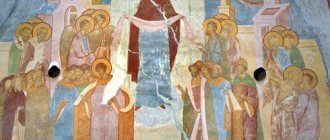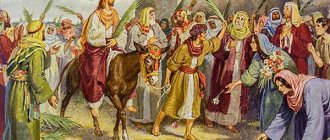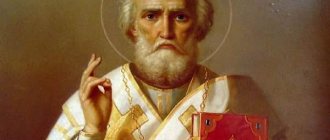The Feast of the Dormition of the Blessed Virgin Mary in Russia is celebrated on August 28 (August 15, old style). The next day - August 29 - Orthodox Christians celebrate the Third Savior in honor of the shrine, which is called the Savior Not Made by Hands . The Third Savior completes the series of August holidays in honor of Jesus Christ : the First (Honey) Savior on August 14 and the Second (Apple) Savior (Transfiguration of the Lord) on August 19 .
history of the holiday
The Dormition of the Blessed Virgin Mary is one of the main Mother of God feasts of the Church.
Some data indicate a connection between this holiday and the most ancient celebration of the Theotokos - the “Cathedral of the Most Holy Theotokos”, which to this day takes place on the day after the Nativity of Christ. So, in the Coptic calendar of the 7th century. On January 16, that is, shortly after the Epiphany, the “birth of the Lady Mary” is celebrated, and in the calendar c. on the same date - “the death and resurrection of the Mother of God” (in the monuments of the Coptic and Abyssinian Churches of the 14th century, which, due to their isolation, preserved ancient liturgical practice, January 16 commemorates the Assumption, and August 16 - the Ascension of the Mother of God into heaven).
In the Greek Churches, reliable evidence of this holiday has been known since the century, when, according to the testimony of the late Byzantine historian Nicephorus Callistus (XIV century), Emperor Mauritius (592–602) ordered the celebration of the Dormition on August 15 (for the Western Church we have evidence not - th, and v. - the sacramentary of Pope Gelasius I). Nevertheless, we can talk about the earlier existence of the Feast of the Assumption, for example, in Constantinople, where already in the century. there were many churches dedicated to the Mother of God. One of them is Blachernae, built by Empress Pulcheria. Here she laid the funeral shrouds (robe) of the Mother of God. Archbishop Sergius (Spassky) in his “Complete month-book of the East” points out that, according to the testimony of the Verse Prologue (an ancient month-book in verse), the Dormition was celebrated in Blachernae on August 15 and that the testimony of Nicephorus should be understood in a special way: Mauritius only made the holiday more solemn. Since the 8th century. we have numerous testimonies about the holiday that allow us to trace its history up to the present time.
What is prohibited to do on the Assumption
Since the eleventh century, the Russian Church has defined the day of the departure of the Mother of God from earthly life as a joyful day, therefore sad thoughts and melancholy should not visit the minds of the Orthodox.
Important! This day is prohibited for swearing, showing anger, starting a quarrel, and using foul language.
Squabbles during this day can bring scandals to the family for the whole year.
True believers, observing the second commandment of Christ about loving your neighbor, must learn to live, thanking God with joy, throughout their lives.
The Assumption Fast, which is celebrated on August 14-27, helps to cleanse yourself of sin, leave behind all grievances and unforgiveness, and come to this holiday with joy and forgiveness.
Popular beliefs
According to popular beliefs, the earth is called mother. At the Assumption it was forbidden to trample the ground with bare feet.
It is also prohibited to “stab” it with sharp objects. Because of disrespect for the land, people were afraid to be left without a harvest the next year.
Walking in the dew threatened with many illnesses.
Nowadays it is believed that uncomfortable shoes worn on a holiday can bring problems for the whole year.
Worn-out, not entirely new shoes at this celebration are not a sign of poverty, but an expectation of comfort until the next holy holiday.
Housewives try to prepare for the holiday in advance so as not to cut anything later; they even break bread products with their hands.
It should be remembered that the Orthodox Church has a negative attitude towards signs and superstitions, so you should not give them much importance.
Festive service
The oldest known rite of service for the holiday is contained in the Georgian translation of the Jerusalem Lectionary - 7th century. [1]. It took place in the Basilica of the Assumption in Gethsemane and included: troparion for chapter 6. “When you passed away...”; prokeimenon ch. 3 “My soul magnifies the Lord”; readings (Proverbs 31:30–32, Ezekiel 44:1–4, Gal 3:24–29); alleluary “Hear and see”; the same as now, Gospel reading (Luke 1.39–50, 56).
Typikon of the Great Church [2] - centuries. contains a detailed description of the charter for the service for the Feast of the Assumption. The celebration begins early in the morning with a procession from the martyrium of St. Euphemia to the Blachernae Church, where the Divine Liturgy is then celebrated. At Vespers there are three paremias, as at the Nativity of the Blessed Virgin Mary (the same as now), the troparion of the 1st tone “At Christmas you preserved virginity” (this troparion is still sung in the Orthodox Church on the Feast of the Dormition), the litany of supplication, reading and pannikhis ( special service on the evening before the holidays). At the liturgy - the same as now, the prokeimenon, the Apostle and the Gospel.
The considered Charter of the Great Church designates only one day for the celebration. The oldest monastic post-iconoclast charter is the Studian Hypotiposis c. - also suggests a post-feast for the holiday (along with the Transfiguration, Exaltation, Nativity of the Virgin Mary, Nativity of Christ, Epiphany and Presentation).
The typicon of the Constantinople Evergetid Monastery (XII century, reflects the practice of the century) already has a pre-celebration and a post-celebration of the current duration (until August 23), but they are distinguished by less solemnity compared to today's practice. Difference with the current monastic pannikhis; number and order of kathismas; way of singing the canon; composition of the liturgy of the catechumens before the Gospel. According to the Studian-Alexievsky Typikon, adopted in the Russian Church until the end. XIV century, the celebration of the holiday takes place on August 18, i.e. on the third day.
In the studio Typicons of the Athos-Italic edition, as on other holidays, kathismas were replaced by special antiphons (which over time will affect the formation of holiday selected psalms). Thus, in the Athonite Typikon, St. Georgiy Mtatsmindeli v. at matins, instead of the usual kathisma, antiphons from the psalms “Praise the name of the Lord...” (Ps. 135), “Lord remember David...” (Ps. 131) and “Praise the Lord from heaven...” (Ps. 148). The troparion of the holiday, according to this Typikon, is “Blessed are you, all of you” (nowadays this is the hypakoi of the holiday; the chant is also contained in some copies of the Typikon of the Great Church).
What needs to be done on this day
A joyful event is celebrated by visiting church and attending a solemn service.
Before the service begins, you must light a candle and pray to bless all relatives and loved ones.
This is a very important day when the Mother of God hears prayers for children in a special way. When visiting church, you should ask:
- health for kids;
- a good share for unmarried children;
- so that they do not depart from the faith;
- for help to overcome worldly temptations.
Advice!
When leaving the church, it is customary to give alms to those in need, begging not only near the temple, but also to those living nearby. Everyone should enjoy this holiday, especially those who are financially vulnerable. The memorable day of the heavenly departure of the Mother of God gives a happy family life to those couples who marry during the holiday.
Housewives are not prohibited from making preparations, especially pickling cucumbers, tomatoes, and collecting vegetables left in the garden.
This time is favorable for forest hikes to pick mushrooms, viburnum, and also harvest pears and apples.
Rite of Burial of the Blessed Virgin Mary
In modern practice, the celebration of the Dormition is often in one way or another associated with the rite of Burial, also inscribed as “Praises, or sacred observance of the Holy Repose of our Most Holy Lady Theotokos and Ever-Virgin Mary.” The Rite of Burial is of Jerusalem (Gethsemane) origin and is an imitation of the Rite of Matins on Holy Saturday. This rank is very late; it is based on festive choruses for the 17th kathisma (such choruses in the 14th-16th centuries were performed on many holidays, and later went out of practice); by the 19th century in Jerusalem these choruses were supplemented with many elements taken from the Holy Saturday service and slightly modified.
In Gethsemane (the sacred place where the event of the Assumption took place), the rite of Burial is served on August 14 according to the old style, on the eve of the Assumption, but preparations for it begin long before that. [3]
In the courtyard of the Gethsemane Monastery in Jerusalem, located opposite the doors of the Church of the Resurrection, there is kept a shroud depicting the Assumption of the Blessed Virgin Mary, used at the Assumption service. The Shroud lies surrounded by candlesticks. Ever since the Feast of the Transfiguration, prayers, akathists and vespers have been served before this shroud every day, until August 12. On August 12 at 2 a.m., the rector of the Gethsemane Metochion celebrates the Divine Liturgy. At the end of the liturgy at 4 o'clock in the morning, the rector, in full vestments, performs a short prayer service before the shroud. Then the shroud is solemnly transferred to Gethsemane in memory of the transfer of the body of the Mother of God there from Zion by the apostles. Many representatives of the clergy with candles take part in the procession (nowadays in the pre-holiday canon it is sung: “Zionians, light candles”). The shroud is carried in front of the clergy by the rector on a wide silk sling over his shoulder with a velvet pillow. The religious procession is usually accompanied by a gathering of a large number of pilgrims. In Gethsemane, where the procession arrives at sunrise, the shroud is placed in a stone cave on the bed of the Mother of God. Here she remains until the holiday for worship.
On the morning of August 14, at about 9–10 o’clock, the service of the Burial of the Mother of God itself is performed, consisting of the singing of the 17th kathisma with refrains - praises similar to those of Great Saturday. The service is performed by the Patriarch. By the time of service in Gethsemane during the Ottoman Porte, according to the description of A.A. Dmitrievsky, the troops of the Turkish garrison arrived, who, positioned on trellises along the path from Jerusalem, met the arriving Patriarch with a military march. After the Patriarch has censed the bed with the shroud of the Mother of God in the burial cave, after the usual start of the service, the bed with the shroud is carried to the middle of the temple under the chandelier. The Patriarch stands behind the bed, and on the sides of him and right up to the royal doors are bishops, archimandrites and hieromonks. The Patriarch enters the cave again to begin from there the censing of the entire temple, which is performed during the singing of the first article of funeral praise: “Life is laid down in the tomb.” The article, as on Holy Saturday, concludes with a litany with an exclamation from the Patriarch. In the second article, “It is worthy to magnify Thee,” the Primate of the Church of the Holy City censes only the cave and the bed, and the cry is uttered by the oldest bishop. On the third article: “Bear all the songs of Thy burial, O Virgin,” the second bishop censes. The third article, as on Holy Saturday, transitions into the singing of paraphrased Sunday troparions “The Council of Angels.” After the litany there is the exapostilary of the holiday (“Apostles from the ends of the earth”), laudatory stichera and a great doxology. During the prolonged singing of the Trisagion, the priests carry the bed with the shroud to the upper platform of the basilica, where a litany is pronounced with a commemoration of the names of the participating clergy and for the Holy Sepulcher brotherhood. The bed is again placed in the middle of the church while the exapostilary and stichera “With thunder on the clouds, the Savior sends the apostles to the One who gave birth” is sung. Then the Patriarch grants dismissal.
The service on the day of the Assumption itself is no different from the usual holiday service.
Vespers on the eve of the holiday is performed separately, without Matins, but at the end there is a blessing of the loaves, which are then distributed to the people. On the feast day of the Dormition, it is customary to kiss the aforementioned shroud every day. At the celebration of the holiday at the end of the liturgy, the shroud is taken back to the Gethsemane courtyard in Jerusalem with the same religious procession with which it was brought.
In Rus', the rite of burial became widespread already in the 16th century. and in the form of commendable articles has long been performed along with the festive service in the Kiev Pechersk Lavra and in the Kostroma Epiphany Monastery. Let us note here the instructions of the Old Believer charter according to the 6th song of the canon: “if the abbot wills”, “funeral singing” is performed in the middle of the temple with candles for everyone - such as in the Kyiv Lavra, without litanies; “If there is a temple (of the Dormition), there must immediately be funeral singing.” The edition of the Typikon currently in force in the Russian Church does not contain the rite itself and the necessary statutory instructions.
At St. Philaret (Drozdov) in the Gethsemane monastery of the Trinity-Sergius Lavra, in addition to the Assumption, also established the feast of the Resurrection and Ascension of the Mother of God - August 17. On the eve of the 17th, the Jerusalem procession took place, and on the 17th, after the liturgy, a procession with the icon of the Ascension of the Mother of God took place.
In 1845, the translation of the Jerusalem Sequence of the Burial from Greek into Church Slavonic was carried out by M.S. Kholmogorov for the Gethsemane monastery from sent by Hierotheus, Metropolitan. Taborsky (later Patriarch of Antioch). The translation was revised and edited by St. Philareta, Metropolitan Moscow. “I wanted to combine the Slovenian type of speech with clarity, so I sometimes changed the order of words and used a few words that were somewhat new, instead of more ancient, obscure or mutual for the current concept,” wrote Archim. Saint Anthony (Medvedev) on October 28, 1846. In 1872, the Jerusalem rite for the celebration of the Dormition was printed by the Synodal Printing House under the title we have already mentioned: “Praises, or sacred observance of the Holy Repose of our Most Holy Lady Theotokos and Ever-Virgin Mary, sung on the seventh and tenth day of the month August, every year, in the monastery of Gethsemane, and in the Lavra it is sent on the fifteenth of August.” In 1913, the 2nd edition was published. Nowadays the rite is printed as part of the Appendix to the August volume of the Menaion.
In parish practice (if there is a shroud of the Mother of God), at present the rite of burial can be performed either on the eve of the Feast of the Dormition, on August 14, old style, at Matins, which corresponds to the Jerusalem tradition, or at a festive all-night vigil, or on one of the next days of the period after-feasts (usually in the evening of August 16 or 17 according to the old style; August 17 is preferable both symbolically (as the third day after the Dormition) and historically (this was the practice in the Gethsemane monastery)).
How did the Holy Virgin deserve the worship of people?
The earthly life of the Mother of God cannot be called ordinary from the very beginning. Even from infancy, little Mary was destined for the mission of becoming a great personality in the history of mankind - to give earthly life to God the Son.
Icon of the Blessed Virgin Mary
Childhood
The Virgin's parents were pious people. The family of father Joachim originated from the royal family of David, the genealogy of mother Anna began with the high priest Aaron.
Being just a baby of three years old, Mary came with her parents to the temple, and was introduced to that part of the Jerusalem temple, access to which was strictly limited even for clergy. Even before the girl was born, her parents dedicated her to God.
The Holy of Holies was the repository of the Ark of the Lord, in which the following were kept under the strictest control:
- stone slabs with the 10 commandments carved on them, given to the prophet Moses by God on the mountain;
- manna from heaven falling from the sky during the exit of the Jewish people from Egypt;
- Aaron's rod, which blossomed while resolving a dispute among the clergy.
Even the high priest entering the Holy of Holies was required to undergo a rite of purification, and the little girl was brought there without observing traditions, for she did not need purification according to Her holiness.
The girl’s life at the temple was filled with prayer, work and handicrafts. She spun flax and wool and embroidered with silk ribbons. Her favorite pastime was sewing priestly clothing. The dream of the young artist was one thing - to serve God.
During her 11 years in the temple, Mary turned into a pious girl, submissive to God, who vowed to remain virgin and belong only to God.
Girlhood time
According to temple laws, girls over a certain age were not allowed to live at the temple; they were obliged to get married.
In order not to break the law and to respect the vow given by the Virgin to God, the high priest Zechariah came up with a special plan. The girl was betrothed to Joseph, an old man aged 80.
The family tree of the carpenter Joseph began with the family of King David. His family strictly observed all Jewish traditions and laws. The Holy Scriptures were especially revered.
Joseph had special character qualities such as:
- modesty;
- sincerity;
- determination;
- nobility;
- peacefulness;
- honesty.
Joseph’s fear of God became the main indicator when choosing a husband for the Holy Virgin, for the Lord saw the carpenter’s heart and entrusted him with the girl. Joseph knew about Mary's vow and promised to respect and support it.
From his first marriage, the carpenter had six children, 4 sons and 2 daughters. Joseph's youngest daughter lived with him and Mary. Both girls became close, like sisters.
According to the word of the Archangel Gabriel, the Virgin Mary received the news of the birth of Jesus, and Joseph was aware that in the womb of the Virgin there was a child from the Holy Spirit.
Earthly life of the Virgin Mary
Born in Bethlehem, Jesus, to whom the Mother of God gave a piece of her flesh, needed care; the pious Virgin provided for him.
The Mother of God was given the honor of witnessing the first miracle performed by Jesus on earth. At the request of the Most Pure Virgin, Her Son turned water into wine at the wedding feast, thereby saving the groom’s family from shame.
Knowing the Divine power of the Son, the Mother of God until now had never asked Him for anything, remaining all the time in obedience and reverence. However, the current situation forced the Mother of God to ask her son for the poor. Jesus, seeing Her sincere attitude towards people, bestows mercy.
In all her travels and sufferings, the Mother was with Jesus, sharing with Him dangers, persecutions, wanderings, but the main pain awaited Mary ahead.
Standing at the feet of the crucified Son, she heard mocking cries and saw all the mockery of His body, but she endured everything in silence, believing in the promises of God. After the crucifixion of Jesus, the Mother of God transferred her care to the apostles, becoming their Mother.
It is said that St. Mary's main attire was modesty and simplicity. Everyone who saw the Mother of God admired her love for people and beauty. The quiet, modest Mother of God remains to this day an example of purity and nobility of soul. Always benevolent, ready to help, respecting her elders, the Mother of Jesus, who lived on earth for about 72 years, left all the women of the earth a vivid example of inheritance.
Appearance of the Archangel to the Virgin Mary
Liturgical symbolism of the iconography of the Dormition of the Blessed Virgin Mary
Byzantine iconography of the Dormition of the Mother of God in its canonical form was formed towards the end of the century. This is confirmed by a dated ivory plate for the setting of the Gospel of Emperor Otto III (1002) from the Bavarian State Library in Munich. This composition was not only a scene of a narrative festive cycle - a depiction of the death of Mary, but also an image of the liturgy with Christ the Bishop, given the texts that served as the basis for the iconography, primarily the apocryphal Tale of Pseudo-John the Theologian and the Words of John of Damascus on the Dormition of the Mother of God.
The Dormition of the Mother of God, like the Resurrection of Christ, symbolized the trampling of death and resurrection to a new, more perfect life of the next century. In the Second Homily on the Dormition of the Theotokos by John of Damascus we read:
“Today the treasure of life, the abyss of grace... is covered by life-giving death and She who in her womb carried the Destroyer of Death fearlessly approaches it, if it is at all permissible to call Her all-sacred and life-giving departure death”; “Looking at Her, death was afraid, for from its attack on Her Son [death] learned from experience and, having already acquired [this] experience, became more prudent”; “But just as the holy and immaculate body of the Lord, which from Her became hypostatic to the Word, rose from the tomb on the third day, so the Mother [had] to be taken away from the tomb and move to the Son. And just as He Himself descended to Her, so She [had] to ascend into the great and innermost tabernacle... into heaven itself (Heb. 9:11-24).”
In the Words of John of Damascus on the Dormition of the Mother of God, various epithets of Mary are repeatedly encountered, which liken Her to a tabernacle, a sanctuary, a meal, a container with heavenly manna, bread, a source of manna, a container for bread, sweet food; the incorruptibility of Mary’s immaculate body is associated with the incorruptibility of the Holy Gifts; the presence of the apostles at the tomb of Mary - with the gathering for the liturgy and their acceptance of divine grace.
In the Third Homily on the Dormition of the Mother of God by John of Damascus we read:
“Now the earthly table, which unartifically bore the Heavenly Bread of Life... was taken from the earth to Heaven...”; “This tomb is more precious than the ancient Tabernacle, for it received... a life-giving meal, which stored not the showbread, but the bread of heaven...”; “Sweet, truly sweet is the drink of wine and nutritious is the bread. The first one makes you happy, and the second one strengthens the human heart. But what could be sweeter than the Mother of my God?
Here is an excerpt from the First Word on the Dormition of the Theotokos by John of Damascus:
“...To God the Word, Who created the tabernacle in Your womb, human nature brought bread baked in hot ashes, that is, the firstfruits of its fruits, from Your most pure blood. [These first fruits] were, as it were, baked and made into bread by the divine Fire...”
In his Second Homily on the Dormition, Mary is defined as “... the sweet Vessel of manna, or, better to say, its true source...”.
It is noteworthy that John of Damascus begins the very text of the Third Word on the Dormition with the fact that his goal is “to offer both to himself and to you, those present here, oh divine, sacred assembly, a soul-saving and saving dish...”. In the Second Word of the Holy Father, the role of the apostles in introducing the peoples to the sacrament is emphasized, and their appearance around the tomb is likened to a meeting of priests at the liturgy:
“Those who were scattered throughout the whole earth, [who] ensnared people ... with the tongues of the Spirit, [who] with a net of words drew [them] from the abyss of error, [to lead] to the spiritual and heavenly table of the Last Supper, where the sacred food was [served] spiritual feasts of the Heavenly Bridegroom... the cloud delivered to Jerusalem..."
Many texts on the Assumption emphasize the incorruptibility of the body of the Mother of God. In Cosmas of Mayum we read: “The King and God of all shows supernatural deeds in you: for just as He preserved (you) as a Virgin at birth, so He preserved (your) body incorruptible in the tomb.” In such a context, this could not but be combined with the idea of the incorruptibility of the Eucharistic gifts.
Let us turn again to the First Word on the Dormition of the Theotokos by John of Damascus:
“...your divine body: sacred, all-immaculate, filled with divine fragrance, an abundant spring of grace, being laid in the tomb, and then raptured into a better and higher region, did not leave [its] tomb without a gift, but imparted to it divine blessing and grace, left it as a source of healing and all kinds of benefits for all who come with faith.”
In the Words for the Dormition of John of Damascus, Mary is called the treasury of true Wisdom, the Royal Throne, the bed, and the bed is called the temple, the throne. This corresponds to the inclusion in the Words of numerous quotations and images drawn from the Books of the Old Testament, likening Christ, Wisdom incarnate, to the new Solomon, and Mary to his Bride; the transfer of Mary's body from Zion to Gethsemane was likened to the third transfer of the Ark of the Covenant by Solomon to the Holy of Holies; the tomb itself is called the beautiful Bride, the bridal chamber. In the Third Homily on the Dormition of the Mother of God by John of Damascus we read:
“The bed of the divine incarnation of the Word rested in the glorious tomb, as in a bedchamber, from where it ascended into the heavenly bridal chamber, so that, reigning most luminously with the Son and God, it left the tomb as a bed for those living on earth... This bed does not contribute to the carnal union of those who love with earthly love, but brings to those who are captivated by the Spirit the life of holy souls, standing before God, the best and sweetest of all blessings.” The Eucharist was the highest expression of this love and was likened to the wedding supper of the Bridegroom of Christ, the Son of the Great King.
All three Words of John of Damascus were read on the feast of the Dormition of the Mother of God on August 15 in the Church of St. Zion at night. In the service itself on the feast of the Dormition of the Mother of God, the main features of this event in Christian history were repeated and revealed: the meeting at the deathbed of the apostles and their participation in the Dormition, the glorification of Mary and her death by angelic forces, the incorruptibility of Mary’s body. The liturgy was served around Mary's bed. Georgian Gospel Aprakos - VIII centuries. celebrates the celebration of the Dormition of Our Lady in a chapel specially built at the foot of Mount Gethsemane, where Mary's body was transferred.
“...The town of Gevsemania, where is the tomb of our Most Holy Lady Theotokos... There are three temples: one on the left hand and in a recess under the ground, where the divine tomb of the Mother of God is. This entire vaulted, spacious, cylindrical temple, and in the middle of it, like an pulpit, stands her coffin, carved from stone in a four-chamber form. And on its eastern side, sculpted from the same stone, like a bed and a bed lined with marble, on it was laid the most pure body of the Most Holy Theotokos, brought by the holy apostles from Zion.”
Abbot Daniel reports about him:
“And on top of the tomb of the Holy Mother of God a very large cell church was built in the name of the Holy Mother of God of the Dormition. ...The tomb of the Holy Mother of God is located below the great altar of this church.”
The Crusaders built a small marble chapel dedicated to the Virgin Mary in the Church of St. Zion, on the spot where, according to legend that spread throughout the century, the Mother of God died. In this chapel there was an altar and an image of the Assumption of the Mother of God, and a service was held in it in honor of the Feast of the Assumption. This means that the bed and coffin of Mary were temple shrines; in the Assumption Church in Gethsemane, the coffin of the Mother of God, located directly under the altar of the church, was given eucharistic significance like the Holy Sepulcher. The composition “Assumption of the Mother of God” in the Zion chapel was also associated with the liturgy.
In the Middle Byzantine iconography of this scene, the bed with the body of the Mother of God was visually likened to the throne, and the arrangement of the apostles in two groups, headed by Peter and Paul, on the sides of the bed, was likened to their presence at the Eucharist and communion under two types. Christ, standing with the swaddled soul of Mary behind the bed, was the image of a bishop at a meal. The image of the Apostle Peter censing in front of the bed apparently corresponded to the censing of the Holy Gifts in the liturgy, and the image of John falling to the bed of Mary corresponded to the priest kissing the throne.
Often in the scene of the Assumption of the Mother of God there were images of two, three or even four bishops - Dionysius the Areopagite, Hierotheus, Timothy of Ephesus and James, brother of the Lord, in accordance with the text of Pseudo-Dionysius the Areopagite, interpolated into the Second Homily on the Assumption of the Mother of God by John of Damascus along with a fragment of Euthymius stories. In the liturgical aspect, their presence in the Assumption scene can be likened to the bishop's communion of the priests in the Eucharist. Angels with covered hands, as for receiving the Holy Gifts, also seem to serve at the liturgy as deacons. In the paintings of the Transfiguration Cathedral of the Mirozh Monastery, the archangels Michael and Gabriel are represented on the sides of Christ in lore.
The liturgical nature of the scene of the Dormition of the Mother of God was sometimes directly indicated by the image of pairs of hymnographers - Cosmas of Maium and John of Damascus, presented, for example, on the western wall of the upper church-tomb in Bachkovo to the right and left of this composition under the arches, and subsequently in paintings of the 14th century.
Dormition: celebration traditions
The Dormition is solemnly celebrated by all faiths, celebrations take place in Jerusalem and in all countries where there are Christian communities. In Gethsemane, where according to legend the tomb of the Mother of God is located, the rite of burial of the Virgin Mary is held. According to Orthodox tradition, the Assumption service continues throughout the night.
In Rus', the Assumption was one of the most important and beloved folk holidays dedicated to the harvest. The holiday was popularly called the First Most Pure Day . (Second Most Pure - Nativity of the Theotokos, September 21; Third Most Pure - Entry of the Mother of God into the Temple, December 4).
The peasants specifically left one unharvested sheaf on the field before the Dormition, which was called the pre-harvest sheaf. On the holiday, the sheaf was solemnly cut and various rituals were performed with it, which were supposed to ensure the safety of the current year's harvest and protect against hunger and crop failure next year.
With the Assumption, the young Indian summer began (until September 11), in addition, on this holiday all “woman’s sins” were forgiven.
The sign read:
“If the weather is good for the young Indian summer, expect bad weather for the old one (that is, since September 11).”
It was not customary to work for the Assumption; hard work, washing, cooking and handicrafts were generally prohibited, but it was possible to start pickling cucumbers.
Also at this time, winter crops began to be sown. There was a saying:
“The First Most Pure One sows the crops; the Second Most Pure One helps her.”
Federal News Agency /
At this time, according to tradition, the time for autumn weddings began, which were mainly held on Intercession (October 14).
Also, on the Assumption, it was customary to consecrate the grain of the new harvest and bread baked from it in churches.
On this day in Rus', bread alms were generously given to the poor and prisoners in prisons. Refusal from works of mercy was strictly condemned; it was believed that a heartless person brings disaster not only to himself, but also to his loved ones and even neighbors.
According to tradition, on this day girls were forbidden to cut their hair and braid their hair, otherwise, according to superstition, they would not get married.
It was forbidden to walk barefoot on the Assumption; it was believed that the earth was watered with bitter tears in connection with the death of the Mother of God and these tears made everything around poisonous.
It was strictly forbidden to quarrel, argue, create scandals, and especially to use foul language; the Mother of God could become angry and send dumbness or even madness.
Prayers
Troparion, tone 1
At Christmas you preserved your virginity, / in the Dormition you did not abandon the world, O Mother of God, / you reposed to the belly, / Mother of the Being of the Belly, / and through your prayers you delivered our souls from death.
Kontakion, tone 2
In prayers, the never-sleeping Mother of God / and in intercessions, the immutable hope / the grave and mortification cannot be restrained: / as if the Mother of the Life / was placed in the life / in the womb of the ever-virgin one.
Greatness
We magnify Thee, / Immaculate Mother of Christ our God, / and glorify the all-glorious / Thy Dormition.
Bible story
Dormition of the Virgin Mary
Canonical texts do not report the time and circumstances of the death and burial of the Virgin Mary. Saint Epiphanius of Cyprus (IV century) wrote about this in Panarion:
“And if some think that we are mistaken, then let them search the Scriptures, and they will find no information about the death of Mary, or whether she died, or that she did not die, or whether she was buried, or that she is not buried. And when John undertook a journey through Asia, it is also not said anywhere that he took the holy Virgin with him, but Scripture simply kept silent about this due to the extreme nature of the miracle, so as not to amaze the human mind... For Scripture stands above the human mind and left it unknown , since the Virgin was an honest and most excellent vessel, so that no one would remain in the assumption of anything carnal about her ... "
The events of the Dormition and burial of the Virgin Mary are known from the later apocrypha: “The Tale of the Dormition of the Virgin Mary,” “The Exodus of the Virgin Mary,” “Letter of Pseudo-Dionysius the Areopagite to Titus.” Therefore, all information is taken from them.
Appearance of the Archangel
At the time of her death, the Mother of God lived in Jerusalem and visited Golgotha and the Holy Sepulcher for prayer. One day, during prayer, the Archangel Gabriel appeared to her, informing her that in three days she would “depart to Christ God.” Calming Mary so that she would be ready for her hour of death, the archangel announced to her:
“Thy Son and our God, with the archangels and angels, cherubim and seraphim, with all the heavenly spirits and souls of the righteous, will accept You, His Mother, into the heavenly kingdom, so that You will live and reign with Him for an endless time.”
To commemorate his words, the archangel handed the Virgin Mary a branch of the tree of paradise, instructing her to carry it before the coffin of the Virgin Mary during burial.
Dormition
The Virgin Mary informed Joseph of Arimathea about the news she received from the angel. Wanting to see the apostles before her death, she turned to God in prayer, and “by the command of God, the angels captured the Apostles who had dispersed with the preaching of the Gospel to the ends of the universe and brought them on clouds to Jerusalem, placing them in Zion in front of the doors of the house where the Mother of God lived.” Having said goodbye to all her loved ones and made orders regarding her property, the Mother of God prepared for death.
This is how Dmitry Rostovsky describes the Dormition of the Mother of God:
“Suddenly in the upper room the indescribable light of Divine glory shone, darkening the lamps. Those to whom this vision was revealed were horrified. They saw that the roof of the upper room was open and the glory of the Lord was descending from heaven - the King of glory Christ himself with tens of angels and archangels, with all the heavenly powers, with the holy forefathers and prophets who once foretold about the Most Holy Virgin, and with all the righteous souls was approaching the Most Pure One. Your Mother."
After this, the Virgin Mary died peacefully.
Burial
The apostles buried the Mother of God in the tomb where her parents Joachim and Anna and her husband Joseph the Betrothed were laid to rest. The most pure body of the Virgin Mary was carried in a solemn procession on a bed through Jerusalem, which was reported to the high priests. The guards they sent were unable to disperse the procession thanks to a miracle: “a cloudy circle floating through the air descended to the ground and, like a wall, surrounded both the holy Apostles and the rest of the Christians.” The high priest Athos, passing by the procession, tried to overturn the bed, but his hands were cut off by an invisible force. After repentance, he received healing and confessed himself to be a Christian. After the burial, the apostles closed the entrance to the cave with a stone and left.
Ascension of Our Lady
According to some apocrypha, the Apostle Thomas did not participate in the burial of the Virgin Mary. He was transferred to Jerusalem from India after the burial of the Mother of God and claimed that the Mother of God was not in the tomb. When the apostles opened the tomb so that he could verify the opposite, the body was not actually there. Then Thomas said that it had been revealed to him how the Mother of God ascended into heaven, and asked that She give him Her blessing. Then the Mother of God threw off Her belt to him, with which she was girded. The stone on which the belt is said to have fallen is located on the grounds of the Russian Gethsemane Monastery of St. Mary Magdalene on the Mount of Olives.
According to Demetrius of Rostov, on this day in the evening, during a meal, the Mother of God appeared to the apostles in the air, surrounded by angels, and greeted them with the words: “Rejoice! “For I am with you always.”
Prayers to the Mother of God
On such a holiday, you definitely need to go to church and pray for the children. Christians believe in the intercession of the Holy Virgin Mary. The Mother of God always responds to the request of mothers to give their children health and a long, happy life. You can light a candle in church for the health of your family and friends.
During her lifetime, the Virgin Mary asked God for everyone in need. After her miraculous ascension, she entered God's kingdom and can ask the Almighty to save sinful human souls. Appearing on the third day after her dormition, the Immaculate Virgin said to the apostles: “Rejoice, for I am with you forever.” On this holiday, you can ask the Mother of God for help and protection. Before prayer, you need to open your soul to the saint, talk about your worries and anxieties. On such a day, the Mother of God will hear one and all.
The Virgin Mary can appear in a dream and tell you what to do right. At night, in a vision, the Holy Intercessor can bring the long-awaited news. On her deathbed, the Mother of God vowed to become people’s protector and helper. Since then, she has not deviated from her word given to Christians and asks the Almighty for everyone.
When is it celebrated?
In 2021, the Dormition of the Immaculate Virgin in Orthodoxy is celebrated on August 28. This date is unchanged. Every year the Assumption is celebrated on the same calendar day. Before the holiday, Orthodox Christians observe a two-week fast. It lasts from August 14 to 27.
The Dormition is one of the 12 twelve, that is, the main church holidays. Festive services are held in all churches. The solemn service on August 28 begins with an all-night vigil. Before the transition to the Gregorian calendar, celebrations were held on August 15th. In the Catholic Church, the Dormition of the Mother of God and her bodily ascension into heaven is still celebrated on this day.

